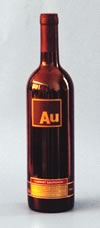from Erica K. Jacobsen, JCE High School Editor
Ever experience the phenomenon that occurs once you’re interested in or working on a particular topic? Suddenly, all sorts of examples related to that topic pop up unexpectedly in your everyday life. The examples may have even been there all the time, but you didn’t really notice them. Deep in preparation for this National Chemistry Week (NCW) issue with the American Chemical Society’s “Chemistry—It’s Elemental!” theme, it happened to me. A surprising instance arrived as a newspaper insert. Our local discount grocery has a frequently rotating stock of inexpensive wine. Very occasionally they publish advertisements about the upcoming grocery specials, along with one or two wine selections. I glanced at the color photos on the front page and was drawn to a simple yet striking image on a bottle of wine (see photo): the letters “Au” in a black box outlined in gold. The ad copy stated “Au is the periodic table symbol for GOLD. Our wine buyers are proud to bring you this nugget, a collection of wines from some of the best growing regions in Australia.” I realized they also mean to connect the “Au” to the fact that the wine is produced in Australia, but I was surprised by their mention of the periodic table. Apparently, even wine can be elemental.
If you look at the Chemical Education Today section of the Journal of Chemical Education’s special October NCW issue, you’ll see it’s grown to epic proportions. The broad appeal and applicability of the periodic table theme became evident once others involved in the chemistry community heard about some of the article ideas. For example, see the series “My Favorite Element”. We invited several authors to submit articles on their favorite elements, beginning with M. Frederick Hawthorne, the 2009 Priestley Medal winner. The idea that many people have favorite elements was underscored when I read the beginning of a March 23, 2009 article in Chemical & Engineering News on Hawthorne. He stated “Boron is my element—not that I own boron, but it owns me” (1). When others heard of the project, many told us their own favorite element, and the series grew. Ober and Krebs even tell us about several invented elements from fantasy and science fiction literature and television shows. What’s your favorite element? The opportunity to share it in the pages of the October 2009 Journal issue are past, but you can still become part of the Division of Chemical Education’s “Elements on Facebook Project”. Rachel Groat and I describe the project and how you and your students can get involved. Each element has its own page on the Facebook social networking Web site. Any Facebook member can visit an element’s page and use the “become a fan” feature, as well as add new information about the element, including videos, images, text, etc. After NCW (October 18–24), JCE will report again on the five elements that have the most fans and the element that most dramatically increased its fan base. Wondering what the top five were when we wrote the article? Take a guess. Then visit Facebook and register your support for your own favorite.
A Farewell to the Moores
The October 2009 issue of JCE is the last for editor-in-chief John W. Moore and his wife, associate editor Elizabeth A. Moore. I think it is one of the best issues produced under their guidance and hope you will agree. I am privileged to have worked with the two of them.
Laura’s Take on the Issue
from Laura Slocum, JCE High School Associate Editor
This issue is full of extraordinary ideas that apply to National Chemistry Week (NCW) and I am looking forward to trying some new ideas in my classroom this year. However, two articles in this issue, not related to NCW, really jumped out at me, especially since I am teaching my Introduction to Biochemistry class in the spring. Millard describes how she uses clips from the medically oriented TV programs ER and House in her biochemistry course. I have talked about these shows and others in class, but have never used the actual clips and will add these this spring. In A Quick and Accurate Oxygen-Based Pressure-Sensor Assay for Catalase Activity, Lewis et al. describe an experiment to follow the enzyme kinetics of catalase on hydrogen peroxide. I have been doing a rather complicated and expensive enzyme kinetics lab that leaves about half of my students frustrated and asking for a different lab—I think I may have found the answer to my students’ request in the Lewis, et al. article. My students have already used gas-sensor probes in a number of experiments in their first-year chemistry course, so they should find this experiment much simpler.
Literature Cited
1. Ritter, S. K. Chem. Eng. News 2009, 87 (12), 12–14 (accessed Aug 2009).




A high school teacher from New York emailed me today to ask for more information about the bottle of wine pictured in this column, to try to find the wine in her own area. For others that are interested, the wine comes from Aussie Vineyards (http://www.aussievineyards.com). The web site has a link for “Where to buy”, sorted by state.